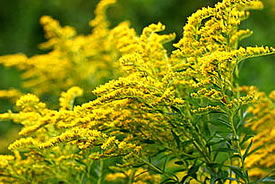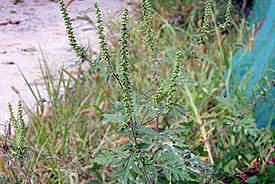In praise of goldenrod (and exposing the real culprit of your hay fever)

Goldenrod (Photo by Liz West, Wikimedia Commons)
I worry a lot about how we don’t understand nature anymore. Now I’m not talking about the value of nature or the importance of conservation. That worries me too, but what I’m talking about is the basic understanding of the plants and animals that co-exist with us. I’ll call this nature literacy. Most of the kids I know can’t identify the common plants and animals that are in their local forests and parks. Parents might be even worse.
What really worries me is the globalization of our nature literacy. Thanks to cable TV, coverage of international conservation issues and the internet, my neighbours and their kids know a lot about pandas, sharks and tigers. Don’t get me wrong — pandas, sharks and tigers are really important, and I’m glad that my neighbours and their kids know about them. However, with the globalization of our knowledge on plants and animals comes a failure to recognize the species that share our local environment. A rich and locally unique palette of plants and animals becomes a faceless and nameless blend of green.
I think goldenrod may be one of the best examples of our faltering nature literacy. Goldenrod is actually a group of plants in the aster family. It’s a big family and most of the 100-plus species (and dozens of hybrids, varieties and sub-species) are only found in North America. Most people are only familiar with the goldenrods that live in open areas — that burst of autumn yellow that emerges from old fields, meadows, roadsides and waste places.
In addition to being a big family, it’s also very diverse. The 41 members of the goldenrod family found in Canada occur in almost every type of habitat. This is reflected in their common names. We have bog goldenrod, swamp goldenrod, prairie goldenrod, rock goldenrod, alpine goldenrod, field goldenrod and seaside goldenrod. We also have goldenrods that live in forests, along rivers and on the tundra. There may be no other group of flowering plants that has evolved to embrace and adapt to the diversity of Canada better than goldenrod.
Although we may ignore the brilliant yellow of goldenrod because we see it in waste places and assume it’s just a weed, Europeans have long recognized its beauty. They have brought it back to adorn the gardens of England, France and Germany. Even the Queen of England has goldenrod in her royal gardens.
Lots of Canadian animals probably wish that we had goldenrod in our gardens. Those yellow flowers provide an abundant source of nectar for bees and butterflies, and are a reliable pit stop for monarch butterflies on their annual migration to Mexico. Goldenrod also provides host to a fly that lays its eggs in the stem. These eggs and the resulting larva cause the goldenrod host to form a “gall” — a hard ball on the stem, where they over-winter. It’s a great strategy (for a fly), except that many of our winter birds, such as downy woodpeckers and black-capped chickadees have figured out that the galls contain a juicy fly larvae and will peck though the stem to get at this avian equivalent of a protein bar. It’s an important meal to help get many of our birds through a long, cold Canadian winter.
You would think that for such a ubiquitous, showy and important species we’d at least be able to identify it and know something about it. Yet many of my neighbours and their kids with, let’s say emerging nature literacy, have come to detest this plant. They almost all think it’s a weed. Most call it ragweed and wrongly accuse it of causing hay fever and other ailments.
Goldenrod has the unfortunate coincidence of flowering at the same time as common ragweed, which is the real culprit for your itchy eyes, sneezes and runny nose. Ragweed is a rather non-descript little plant without showy blooms because it does not need to engage pollinating insects for plant sex.

Ragweed (Photo by Dalgial, Wikimedia Commons)
Unlike goldenrod (and other flowering plants), which must seduce insects or hummingbirds to carefully spread its (relatively) heavy pollen grains from flower to flower by offering a nectar reward, ragweed has countless tiny pollen grains that it aimlessly ejects into the wind with the hope that some will happen to find another ragweed flower. As these grains blow in the wind, most will never find their way to another ragweed flower. They do however seem very proficient at finding your nose and eyes. It’s this irritation of tiny, drifting ragweed pollen that causes your hay fever.
Case closed: goldenrod is wrongly accused of hay fever. A false conviction through botanical association.
We should all celebrate goldenrod. It is a truly Canadian group of plants that deserves the same status as the maple, moose and beaver. Seek it out with clear eyes, breathe deeply, discover your local goldenrod species and spread the important word that this Canadian wildflower does not cause hay fever.
Editor's note: Ragweed photo updated November 12, 2014.


